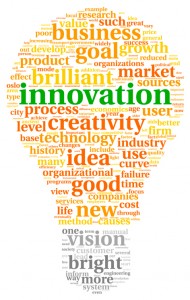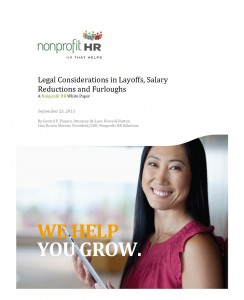

But few nonprofits should actually be afraid of leadership development since often it indicates growth and mission success.
When your organization is open to examining your current organizational goals and is ready to actively assess your employees and positions to see if you have the employee talent to lead your organization forward, there are hundreds of resources for leadership development.
Thankfully, The Bridgespan Group has put together a Nonprofit Leadership Development toolkit, with videos based off of their own leadership development research, that can help you tie the skills and talents your organization will need into your strategic planning efforts.
UST’s ThinkHR hotline can also help you prepare for future leadership needs with expert job description builders, salary benchmarking tools and more than 200 on-demand courses for both management and employees! Visit the webpage here.
Learn more about the HR resources available to UST members by calling (888)249-4788 today.

But according to research done by the Social & Demographic Trends arm of the Pew Research Center, Millennials are forging an identity that is “confident, self-expressive, liberal, upbeat, and open to change”– which makes them perfect candidates for your next open Board seat. (Read the full report here.)
Creative and highly adaptive, many Millennials are defined by their upbeat energy, positive outlook and high level of inclusion. Conversely many Boards are getting a bad rap for being exclusive, untouchable, and far too opaque in their conservative decision-making.
According to advocates for younger board members, having Millennials on your board has many benefits and advances your organization in ways that may be overlooked by those quick to dismiss the young. These include:
Read more of the benefits of having younger board members on your Board.
Take the quiz to find out how Millennial you are.
Do you have younger board members at your organization? How did you find them? Tell us about your board demographic!

For those of us who help run the day-to-day operations of the UST program, there is a special thrill in hearing how each of our members is able to make an impact in their community through after school programs, health and human services, meal delivery programs, arts, literacy advancement efforts, animal advocacy, and so much more! We wanted to reach into our local community and get help illustrating (literally) all of the types of nonprofits UST serves. So we asked the children that participate in our local Girls, Inc. and Boys & Girls Club programs to help us by entering a calendar contest. And within a month, we received more than 100 incredible drawings!
The only problem is there are only 12 months in a year! So after a difficult selection process, we presented each of the winners with awards, and threw all of the participants a pizza party. Said Tristan from the Boys & Girls Club of Carpinteria to the local newspaper, “I was really excited I won because I never thought I was that good at drawing.” His entry in the Museums category is the winning image for May.

Founded by nonprofits, for nonprofits, UST is the largest unemployment trust in the nation, providing nonprofit organizations with 10 or more employees a safe, cost-effective alternative to paying state unemployment taxes. Since 501(c)(3) organizations are federally allowed to opt out of paying into the state unemployment tax pool and can instead reimburse the state only as they incur unemployment claims, UST member organizations can take advantage of this savings benefit while also being protected through their UST account reserve and expert claims management. And now through ThinkHR, they will also benefit from live HR advice when they need it.
ThinkHR Live now provides UST members with access to a live phone HR hotline with written follow-up on complex issues or researched matters, usually within 24 hours. All hotline representatives are certified professionals in human resources, and help employers to stay in compliance – an important part of any organization’s human resources practices.
In addition, ThinkHR offers downloadable HR templates with forms, documents, tools and checklists for every HR department; a job description builder and salary benchmarking tools; 200+ online employee training and compliance courses for both management and employees; and bi-weekly legislative and HR e-newsletters.
Over the first 8 weeks of membership, UST members will also receive a weekly email from ThinkHR with account tips and features to help them get the most out of their account.
Every year UST provides its members with new educational content and support. Often focusing on unemployment costs, unemployment claim management methods, HR-related procedures and case studies, UST’s informative materials and dedicated partner services like ThinkHR are designed to help nonprofits save money and build greater resiliency. Visit www.ChooseUST.org/ThinkHR to learn more.

The South Central Behavioral Health Network (SCBHN) is made up of 39 mental health and substance abuse programs that are funded by the Connecticut Department of Mental Health and Addiction Services. Focusing on programs that benefit the homeless and addicted populations served by member agencies, SCBHN runs multiple programs that offer addiction counseling and support, job training, and grants for consumer-run projects.
It also operates a very successful program which allows homeless people to move into sober living houses and provides them with case managers.
Each year, the SCBHN houses more than 130 people, and their programs focus on helping people successfully stand on their own two feet. Believing that those who have already experienced the success of conquering addiction and homelessness provide the best examples to those still struggling, SCBHN provides those connections and helps make sure that peer counselors are always available.
A very unique program, SCBHN began as a membership organization for the substance abuse and mental health organizations in the area surrounding New Haven, CT. Now providing direct services to clients of their membership agencies, SCBHN faces a challenge because they have committed themselves to hiring peers to help those they serve. For them, this means that they have committed to hiring two part-time peers for each position, instead of one full-time entry level employee who had never experienced the hardships of homelessness, substance abuse, or mental health concerns. In the last few years, SCBHN has been “hurt around the edges” as donors for their homeless programs dropped out, which forced them to cut back on the number of people they can serve, even as the population grew.
Needing to save money and feeling that self-insuring is far too risky for the majority of nonprofits, SCBHN joined UST and was able to see an immediate decrease in their annual rates.
“What’s the downside of joining UST?” asked Executive Director Edward Mattison. “I certainly confess that I didn’t pay any attention to unemployment before it became important, but the Trust is less expensive than staying with the state and it’s far less risky than trying to self- insure.”
Mattison’s sentiment proved to be extremely true when SCBHN was forced to dismiss an employee who clients alleged was stealing money from them. After dismissal, the employee filed for unemployment benefits claiming she deserved them for her work at the agency, but SCBHN felt that she had harmed clients and should not receive benefits. “The claims staff has [always] been very helpful for us in prepping us for claims interviews and hearings,” said Mattison.
Solution
Working with their claim monitor and hearing representative to figure out how to best approach the situation, what documentation to provide for the hearing, and who should be interviewed, SCBHN was able to win the claim early on.
“I’m not a person who wants to deny people their rights, but the idea that someone who was allegedly stealing from clients should receive benefits made me very angry,” said Mattison.
Summary
Looking to save on operational expenses, SCBHN learned about UST and the benefits of joining a Trust. Being offered substantial savings which allowed them to put more money back into their homeless programs, SCBHN finds UST to be important to their mission because, in part, they are protected from high state rates and can get help in defending themselves against fraudulent or inappropriate unemployment claims.
In the case of the fraudulent claim, claims representatives were able to help SCBHN collect all the necessary information for the unemployment hearing they had requested. Organizing statements, testimony, and the evidence, their representative was able to help SCBHN successfully defend themselves against the claim and save their homeless clients from being offered fewer services. UST’s claims administrator then went on to help SCBHN set up stronger documentation systems to prevent any future issues with employees who harm clients.

So what better time than to throw a festive office party to commemorate yet another successful year? (Or even to ease the pain of a bad one.)
While holiday office parties can seem more like a chore than a reward for both you and your employees, following a few simple steps can help transform your party from dull to unforgettable.
Party Do’s
Party Don’ts
Throwing a holiday office party requires the utmost care and an eye for details. Though it’s important to emphasize responsible behavior, remember that these annual parties are meant to be a reward for your employees. Given the right venue, food, and attitude, your holiday office party will be a hit
Read more tips on creating a successful holiday office party here.

This year online donations by Blackbaud rose 90% to $19.2-million, with the average gift hovering around $142. Network for Good, which also processes online donations, said it handled $1.8-million in gifts on Tuesday.
In 2012 there were more than 2,000 recognized #GivingTuesday partners in the U.S. During that 24-hour period, Blackbaud processed more than $10 million in donations while DonorPerfect recorded a 46% increase in online donations on that day over the Tuesday after Thanksgiving in 2011.
The #Unselfie, in which participants take a picture of themselves holding a piece of paper with the name of a charity they support– either through volunteer work or donations– and post it to their social media networks, helped contribute to the trend and was a leading keyword in the days leading up to Tuesday.
What was your favorite #GivingTuesday campaign? Tell us about it on Facebook and Twitter.

Devoid of strict time restraints and monotonous drills, great office coaching requires patience, consistent hand-holding, and an assortment of skill-set conditioning.
No matter how talented a supervisor is, an organization’s success rate is greatly impacted by the competence of its workers. Specifically, nonprofits heavily rely on their employees’ ongoing drive and development in order to further advance their mission.
Here are 6 essential elements required for successful coaching:
Effective coaching requires a formulaic methodology, which can only be achieved through trial and error. Backed by mutual trust and strategic thinking, the best workplace coaches inspire their employees to continually raise the bar. Great coaches encourage stronger internal relationships and a constant evolvement of talent—paving the way for a more successful organization.
Read more coaching tips within the workplace here.

Innovation most often occurs when something new or different is introduced— often a product or service. Giving nonprofits a leg up on their competition, creativity and innovative ideas can help advance mission objectives.
Learning how to increase productivity, whilst saving time, money, and other resources, requires an extensive process of trial-and-error. However, due to a lack of encouragement and seldom office-wide participation, many nonprofits are handicapping their potential innovators.
Innovative ideas within the workplace are often unheard or simply ignored. Afraid of stepping outside of procedural guidelines, many employees shy away from sharing their creative input—especially to higher authority figures.
Follow these 4 strategies to make innovative thinking an accepted standard for every job position:
Innovation provides organizational growth opportunities and keeps your nonprofit from remaining static. Through allocated resources and abundant reassurance, your employees will adapt innovative thinking as a second-nature behavior. Building a unified team effort, through open brainstorming opportunities, will create inclusive internal relationships and strong external impressions.
Learn more tasks to breed innovation here.
The Council of Community Clinics (CCC) provides centralized support services to 16-member community clinic and health center organizations operating nearly 100 sites in California’s San Diego, Imperial, and Riverside counties. Their mission is to represent and support community clinics and health centers in their efforts to provide access to quality health care and related services, with a special emphasis on serving low-income and uninsured populations. They strive to be the common voice by building and strengthening relationships with strategic partners to develop sustainable resources and healthier communities.
Founded in 1977 the CCC helps its community clinics provide care to 1 in 6 San Diegans. And, since the County of San Diego does not operate a public hospital or public clinics, the CCC-member nonprofit community clinics and health centers are one of the few safety nets for primary care services for low-income and uninsured individuals.
Challenge
Several years ago, during the height of the Great Recession, the CCC faced a negative budget and used their entire monetary reserve which had been built over years of careful spending. Even with the extra monies at their disposal, the agency had to do a large layoff to continue to provide support and services. “It was incredibly difficult,” said Tracy Garmer, Director of Human Resources at CCC. After the state was fully reimbursed for all the claims, CCC’s UST reserves were drawn down and the organization took notice of their relationship with the Trust for the first time.
“When I first got here- having come from the for-profit sector- I didn’t really know about the Trust, and I was told we were working off a credit, so it didn’t really rise to a high level of interest,” said Garmer. After the state was reimbursed, the CCC had to re-build their UST account so she felt she needed to learn more about how the Trust operates and if it was still their best option.
“When I called I talked to several people that were extremely helpful in explaining that we were only paying for our own claims, versus what we would be doing in the state system. I emailed back and forth with the Director of Operations at UST and ended up being able to ask for a review of our rates.”
Solution
Having learned about how UST works and how the Trust ensures that each member is only paying for their own unemployment claims, CCC was able to get their rates reviewed and reduced while they re-built their reserves. “When I called to inquire about my rate, the Trust was willing to look at and re-calculate my rate for me. We had gone years and years without large layoffs, and UST made a decision about CCC as an individual company, rather than just lumping us in with everyone else. It’s something I highlight to people that are looking at going into the Trust.”
For CCC, early education wasn’t high on the list of immediate to-dos, but when their rates changed and they called on UST to explain, the Trust was able to offer information to help deter future unemployment costs, as well as provide information about how a layoff affects their account. One of the greatest offerings for nonprofit employers who are expecting layoffs is to call UST and ask their dedicated claims reps questions before making any layoff decisions to see if there are any other approaches, such as partial layoffs, that can save their nonprofit money and reduce claims costs in the long, and short, run.

The Financial Accounting Standards Board (FASB) has released two updates to accounting standards that affect nonprofit organizations.
Accounting Standards Update (ASU) No. 2013-06, Not-for-Profit Entities (Topic 958) Services Received from Personnel of an Affiliate, requires that if a nonprofit receives donated services from an affiliated group, the cost of the services must be measured in the nonprofit’s financial statements at the donor’s actual cost.
ASU 2012-05, Statement of Cash Flows (Topic 230) Not-for-Profit Entities: Classification of the Sale Proceeds of Donated Financial Assets in the Statement of Cash Flows, generally requires organizations that convert donated securities nearly immediately into cash by selling the securities to classify the related cash receipts as cash inflows from operating activities, unless the donor restricted the use of the contributed resources to long-term purposes. This change is effective prospectively for fiscal years beginning after June 15, 2013.

The pitfalls of failing to make your new employee feel welcome and successful on their first day is two-fold though; in part it deflates their expectation about what their experience working with your organization will be. More importantly though it devalues their time at your nonprofit and elongates the onboarding time.
Imagine showing up to work on your first day only to find that nothing has been prepared around your arrival. No computer has been set up. No orientation paperwork has been prepared. No introductions are made. Overall, it seems as though no one at your new job cares that you were hired. How long would it be before you began looking for another new job?
Now imagine a more ideal situation: Your hiring team sent you a welcome note with a first day agenda before you began, and then on your first day, your desk, computer, office supplies, etc. are all ready for you. Co-workers casually drop by between meetings to welcome you aboard and your hiring manager makes vital introductions between you and your immediate team. Orientation materials are prepared and flexible, with small projects and onboarding goals given to you; lunch invitations are extended to help you meet your new co-workers.
Chances are you wouldn’t be as quick to resume your job search because your new organization and co-workers seem excited to have you along.
That initial sense of belonging and preparation goes far.
By demonstrating to new employees that you are excited to have them on board, and that you’ve taken the time to help them get up to speed, you’ve helped lay the earliest groundwork for success. And then as the employee goes through the onboarding process, they have the right contacts, and the right tools, to find the information they need about your organization, donors, and clients to further your mission.
What other onboarding sins have you seen companies commit? Do you have a favorite successful onboarding story?

This article is the second in a series intended to help non-profit stakeholders better understand financial statements in order to make intelligent use of the information. The first article, Financial Statement Basics, reviewed the three primary financial statements: the Statement of Financial Position, the Statement of Activities and the Statement of Cash Flows.
Next, we will look more closely at this “accounting trinity,” examining the relationships between statements and the process of capturing financial data and producing statements.
The Accounting Trinity
The three primary financial statements constitute the organization’s center of gravity. They are a three-ring circus. The Statement of Activity draws the most attention, but you need to watch in all three places!
How do the statements interact? The Statement of Financial Position is the sum total of all Statements of Activities over the life of the organization. The Statement of Activities and the Statement of Cash Flows report very similar information. The Statement of Activities reflects current-period activity on an accrual basis (income recorded when earned and expenses recorded when committed). The Statement of Cash Flows reflects how cash was created or used during the current period. The Statements of Activities and Cash Flows are formatted very differently, however.
Items to look for and consider on every financial statement include:
Read the rest of the article, which covers Internal Controls and Governance here.

For those who fail to respond to a state request for information, the penalties quickly add up, and could end up costing them their right to fight improper claims.
The expert claims administrators at Equifax Workforce Solutions (WS) have written a white paper entitled Unemployment Insurance (UI) Integrity: A Focus on Compliance to help impart meaningful advice around the federal mandate.
“In 2009, with unemployment rates nearly double historical norms, UI benefit payments increased significantly and reached an annual high of nearly $80 billion. As the effects of this recent recession continue to impact unemployment reserves, a renewed focus has been placed on the integrity of the UI system as states look to replenish insolvent trust funds while minimizing benefit overpayments moving forward.”
– Greg Good, Equifax Workforce Solutions
For more information on how your state’s legislation (or lack thereof) will affect your organization in the next few months, UST members can contact their WS claims representative directly.
Tuesday, October 22nd, is the deadline, set by Federal law, for all 50 states to enact their own UI Integrity legislation. But will all 50 states actually be compliant? Well, probably not.
As of this publication, 22 states, and D.C., have not yet passed any legislation in relation to Sec. 252. (Neither has Puerto Rico or the Virgin Islands.) Of those, only 7 have pending Sec. 252 compliant UI integrity legislation.
Sec. 252’s mandate required states to require employers to respond in a timely and adequate manner to all state requests for UI benefit information in order to reduce improper payments. If an employer fails to respond in a timely or adequate manner, it becomes the employer’s responsibility to pay for either part of or all of the improper payments made to claimants.
Nonprofit employers participating in the state UI system can opt out of paying their state unemployment taxes and instead directly reimburse the state for the dollar-for-dollar cost of benefits paid to their former employees. By participating in the Unemployment Services Trust (UST) nonprofits with choose to directly reimburse the state have added help in ensuring that all communications are timely and adequate– but should a claim have to be tried, expert hearing representatives aid our members in presenting the best witnesses and evidence available.
Read more about your state’s legislative actions here.
Just two decades ago, jobs were for life – even if you hated yours. Offices were often dark and dingy, promotions were rare, there was no such thing as ergonomic desks and even smoking was allowed indoors. Today, not only are office spaces bright and more cheerful but many companies are now offering the option to telecommute. There are also more efficient systems in place, better laws protecting employees and far better benefits than ever before. And let’s not forget the in-house gyms, team building excursions, methodical review processes, and the boundless opportunities to grow. So what gives? Why are so many U.S. workers unhappy at work?
Job misery can have a devastating impact on individuals, and their employers. Nowadays, there are countless studies surrounding the decline in employee engagement – Gallup, Randstad and Mercer, the list goes on. Gallup has been measuring employee engagement in the United States since 2000 and finds that a whopping 77% of workers say they hate their jobs. Many report feeling no real connection to their work and state they are growing to resent their employers. Randstad has found that disengagement leads to some pretty bad habits – workers admitted that while on the job, they drank alcohol, took naps, checked or posted on social media, shopped online, played pranks on co-workers, and/or watched Netflix. The pressures modern day workers are clearly causing employees to feel burnout which is a natural reaction to stressful environments, or long workdays, but job dissatisfaction at this level usually occurs after long periods of unresolved issues.
One of the biggest problems seems to be having the wrong management in place. When the wrong person is hired or promoted to a management position, nothing fixes that bad decision. Not compensation, not benefits – nothing. When employees feel that their manager has little to no interest in them as human beings – their personal lives, their aspirations and their interests, especially at work – there is bound to be job misery. If you start typing “my boss is” into the Google search engine, you get options that include “crazy”, “lazy”, “bipolar”, “abusive” and “a tyrant”.
If you do the same Google search for “my job is”, it reveals a rather bleak outlook of life in the office by finishing your sentence with “killing me”, “stressing me out”, “ruining my mental health” or “draining my soul”. Those are some pretty strong comments and cause for concern. Most alarming of all – if you type “my job is stimulating”, Google assumes you have made a typo and suggest you must have meant “not stimulating”. Workers also feel they are expected to “do more with less” – blaming business owners who aren’t willing to expand their budgets to hire more people or provide better compensation to those already in place. Losing your best people because they’re stretched too thin can be costly so many employers are getting creative. Benefits can come in many different forms – ranging from flexible hours, stipends for commuting, increased vacation time or robust development programs.
It’s important for employers to be aware of these situations, evaluate if they’re a sign of a larger issue and identify what they can do to help. Workers crave development, advancement and purpose and when they don’t’ have it, they will move on.
On Monday, CNN Money published an in-depth review of government overpayments within the UI system and their findings. Although the findings do recognize the value of UI benefits to those receiving them properly, improper payments are simultaneously distressing for those who oversee limited budgets and work on shoestrings.
Digging through reports from the U.S. Department of Labor, the Campaign to Cut Waste, and individual state records, CNN found that an estimated $14 billion in benefits were paid out improperly during fiscal 2011. That’s more than 10 percent of all the jobless benefits paid out last year.
But some states did far worse than the national average. For instance, in Indiana, which has become known for bad spending habits, more UI payments made were made in error, or improperly, than were made correctly. Indiana actually made more improper payments than proper payments…to the tune of at least $1,743,109,894 over the last three years.
The blame doesn’t only fall on one or two states though. Unemployment Insurance has the second highest rate for improper payments of any federal program.
But, finally, something is being done. Sort of. A little bit.
The U.S. government and many states are trying to recoup their losses and avoid future overpayments.
CNN found that the majority of the UI benefits improperly collected go to check cashers who either aren’t actively searching for a job, were fired or quit voluntarily, and those who continue to file claims even after they’ve returned to work.
Although people do deliberately defraud the system and use fake documents or identities to collect benefits, the current focus is on establishing preventative methods to recover the money that has been lost.
The crackdown won’t help your nonprofit though.
Despite nearly half of all improper payments being deemed “recoverable,” the money will be returned to the federal government. There is no indication that the money will be returned to the employers who were overcharged, or that they’re tax rates will be positively affected by the discovery of errors.
Only a quarter of the estimated actual recoverable payments have been recovered so far. For the most part, when the government discovers someone was overpaid, it often issues a letter asking the claimant to return the extra funds. But the repayment can be waived in many states if the UI beneficiary can show that they’re in financial distress and didn’t actively intend for the error to occur.

Stellar recruiting and retention strategies are key to a nonprofit’s growth, but sometimes those solutions do not align with budgets. With the increasing rate at which talent moves through the nonprofit sector, it’s more important now than ever to reinvent the wheel when it comes to investing in employees.
There are more and more people seeking to serve a higher purpose and one of the ways they see to accomplish that is to grab an opportunity to craft a mission-driven career. If the nonprofit sector can’t demonstrate that they offer viable career opportunities within a strong organizational culture, they will miss the chance to cultivate future talent. The biggest talent acquisition challenge nonprofits face is limited budgeting but it’s important to remember that at the end of the day it’s the people that fuel the nonprofit sector – not just the donors and the volunteers but most importantly, the people who work for you.
Gaining a better understanding of how the leaders in your organization think about the development of talent, will allow you to start aligning those ideas with the overall goals of the business. Focus on your assets and what opportunities as a whole your organization has in its sights and commit to those aspirations by investing in the people. Creating an effective workplace isn’t just about compensation. Employees consistently rank company culture, leadership, career growth and work-life balance right up there with pay. The act of investing in talent sends a clear message that the company values its people by increasing morale, performance and retention.
You can make gradual improvements and see major results. Here are some things to consider:
It doesn’t hurt to also consider how much philanthropic capital is routed to talent efforts? Review where your donors dollars are going and make a case to shift some of those funds if there is currently no talent investment already set up. Grantmaking needs to intentionally invest in talent to keep top talent engaged and start Initiating conversations regarding the value of employee retention.
People are the most important asset—driving impact, performance and sustainability in the sector. No matter your nonprofit’s budget, you can have a strong organizational culture even in this time of uncertainty and budgetary struggle. And in fact, if you hope to advance your mission, you must make these types of changes. Take the time to invest in your teams and systems to stay ahead of the talent curve.
Transportation benefits can be a great employer-incentive to offer employees. Whether it be for public transit or public parking—these benefits can be paid to a 3rd party transit or parking company or directly to employees. However, due to the latest federal legislation known as the Tax Cuts and Jobs Act, employers may no longer deduct transportation fringe benefits as their own deductible business expenses. When it comes to nonprofit employers that provide this benefit, they are required to report and pay the tax on the value provided as taxable “unrelated business income.”
So what specific impact does this act have on nonprofit employers? This Act requires an unrelated business income tax “UBIT” on nonprofit organizations for providing transportation fringe benefits. If a nonprofit employer uses some of its revenues to pay for employees’ transportation benefits, then such revenues will be taxed to the employer. In addition, these nonprofit revenues would not otherwise be taxable, given the nonprofit’s tax-exempt status. This change is meant to level out the employer tax—providing more of a unity between taxable and non-taxable employers in terms of taxable income to the employer.
A UBIT is the income a 501(c)(3) nonprofit organization can generate from a trade or business that is commonly carried on by the organization and is not related to the organization’s exempt purposes. Prior to the Act, a 501(c)(3) nonprofit organization’s unrelated business income was subject to a tax rate determined under a marginal rate structure in which the lowest tax rate was 15% and the highest tax rate was 35%. This Act removes this marginal rate structure and offers a flat rate of 21% on unrelated business income. With that being said, a 501(c)(3) nonprofit organization’s expenses related to the provision of qualified transportation benefits will now be subject to the flat UBIT rate of 21%.
For the nonprofit sector, treating transportation fringe benefits as unrelated business income will likely result in new reporting and potential tax liability implications. Also, the IRS has not provided any specific instructions on the estimated payment requirements for taxes associated with transportation fringes. Until additional information is given, it would be in the organizations best interest to follow current standard procedures for tax payments that are associated with Form 990-T.

According to global research about hiring trends published by Development Dimensions International (DDI), half of new employees report that they are experiencing buyer’s remorse after accepting a recent job offer.* But new employees aren’t the only ones rethinking their employment.
Many employers surveyed also reported that they are questioning whether they have made wise hiring decisions, with 1-in-8 new workers employed during a 12-month period having proved to be a “bad hire.”
When staffing directors were asked what the top reasons for hiring mistakes were, nearly one-third of respondents blamed an over-reliance on hiring manager evaluations, while only 21 percent pointed to candidates that had oversold their skills.
And because interviews are one of the best ways to determine how a potential candidate will perform in the role, bad interviews can be poisonous. But only 1-in-3 staffing directors feel that their hiring managers are skilled at conducting high-quality interviews, or are satisfied with their company’s training program for interviewers.
In better news, further research revealed that just over half of all new hires would rate themselves as confident in their decision. Delving deeper, many of those who reported a lack of confidence found that the hiring process had failed to paint a realistic picture of the job, department and company they are now employed by.
On the other hand, in companies where the hiring process yielded an accurate portrayal of the job, company, and department, new hires were far more confident in their decisions, less likely to immediately begin scanning job boards, and highly engaged with the job and their workplace.
So what’s the best way for a nonprofit to address these concerns?
Well-trained hiring managers, realistic portrayals of what the position is really like, and good interviews!
Read more about the research by DDI International at SHRM. And come back tomorrow for Part 2: Hiring Tips for Managers and Making Your Interviews Work.

If your organization is considering having an audit for the first time or changing auditors, it is wise to exercise due diligence when obtaining bids for services. With the continued focus on transparency and accountability by government agencies, donors, parent organizations and the general public, the selection of a qualified certified public accountant (CPA) has become increasingly important.
Quality audit and accounting services help nonprofit organizations safeguard their assets; improve internal controls and efficiency; complete timely and accurate returns to comply with federal and state regulatory filing requirements; and stay on top of regulatory requirements, accounting standards and industry best practices.
Before you request bids, your organization needs to answer a few key questions:
Gone are the days of calling a couple of CPAs to say, “Give me a bid,” and reaching an agreement with a handshake. Today’s organizations need to be conscientious about their selection of a CPA. Conducting a diligent and thorough selection process not only satisfies key stakeholders, but ultimately helps protect the organization.
Barry Omahen, CPA, is the Managing Partner of Lindquist LLP, a certified public accounting firm specializing in audits of not-for-profit organizations and their related employee benefit plans. Barry’s chief responsibilities include supervising Lindquist LLP’s day-to-day operations and the firm’s quality control review process. Email Barry at bomahen@lindquistcpa.com.
Stephanie Kretschmer, Marketing Manager, helps the professionals in Lindquist LLP’s four West Coast offices attract and retain clients. She oversees firm communications and has responded to hundreds of requests for proposal in her career. Email Stephanie at skretschmer@lindquistcpa.com.
To learn more from Lindquist’s nonprofit-focused CPAs, watch the recorded webinar: “Beyond the Numbers- How to Review your Organization’s Form 990.”

Have you ever considered different ways to engage your employees at your nonprofit? High performing companies like Google, Zappos, LinkedIn and other organizations have found a way to have both high productivity among their employees along with profitability and it’s all due to creating a fun work environment. When looking at these highly successful companies, they have been able to incorporate fun into the foundation of their culture. While having fun at work may not produce results on its own, it will make your nonprofit organization stand out among your competitors and spark the interest of future employees who are looking for new employment.
Prioritizing fun in the workplace can have a direct impact throughout your organization in ways that you may not expect – such as organizational health. Fun at work can be used to encourage participation amongst employees, making them want to engage in wellness programs. Productivity; fun can offer your employees a break or distraction from everyday tasks, creating valuable break time. Engagement; when employees are engaged they tend to be more enthusiastic about their work.
Many workers have a tendency to imagine the ideal work environment and can’t seem to shake the idea that there’s always something out there that is a better fit for them. This can make employees only look at the flaws of their current work environment rather than seeing its potential. Discussing such concerns with your manager and/or leadership will help them better understand the issue at hand and work together to create a fun workplace.
While fun at work can build solidarity, connections and an outlet for workplace stress, the BIG question is… how do you get started? Since this is a cultural change, no one single event or two can single handed lee change a work environment. You can begin by assessing your culture. Ask yourself if you see how the value of fun can fit and then explore how the fun can become a part of your operations. The next big revolution in the working world is focusing in on culture.

Sedia ruled the law incorrectly forces unions to represent workers who don’t pay union dues.
Read more about the fight, and what experts from all sides of the fight predict will happen, here.

While it is true that American organizations are one of the top most productive business sectors in the world, lack of vacation will inevitably lead to poor physical and mental health, as well as increased turnover rates. Vacations are imperative to maintaining vitality and work ethic throughout the office—increasing both productivity and happiness with one’s job and others.
With 61% of employed Americans expecting to work during their summer vacation, it’s no wonder many employees lack enthusiasm when planning their vacation time. Here are some prevalent work-related activities vacationing workers often find inevitable:
Developing stress prior to, during, and after vacation, due to interrupted work flow and lack of routine, many workers fail to recognize the positive effects vacation has on one’s work.
Use these methods to make vacations relaxing and work-free:
Vacations are crucial to a worker’s sanity and general attitude towards the workplace. Though it’s tough to step away from the computer and turn off the smartphone, time away from the office will provide you much needed rest, and the break you deserve. Vacations are what help employees remain satisfied with their jobs, in turn keeping organizations competitive and successful.
Learn more about vacation and work time here.

For nonprofits, employees’ collaborative efforts are often the key element to mission advancement But clashing personalities working toward the same goal can lead to resentment and impatience in the work place.
Learning to recognize and understand others’ personality strengths and weaknesses can help you appreciate the diverse environment you work in Specifically, nonprofits can take advantage of their diversity when it comes to improving their employment procedures and ensuring ongoing structural soundness.
Basic working styles can often be separated into 4 broad categories:
Whichever working style team members possess doesn’t really matter by itself What most affects a nonprofit’s success is the compilation of strengths your team brings to the table and your team’s ability to successfully work together as a cohesive unit. As long as you understand and utilize everyone’s unique abilities, pertinent to your team’s progress, your nonprofit will continue to flourish.
Discover which working style you have here.

Though prioritizing leadership development is a step in the right direction, nonprofits must simultaneously analyze and define both strategy and leadership development procedures in order to transform goals into achieved reality.
Nonprofits often lose momentum and general direction after failing to go over the specifics. More often than not, leadership development procedures fall into generalized categories. Because no one strategy or goal is alike, it’s important to identify the specific skills required for every set objective.
When looking at future development plans, your organization must develop a consensus around what skills your employees, leaders, and future leaders currently possess, and what behaviors will be required for future endeavors. Identifying the gap between present and future skill sets will better allow you to create a plan of action to achieve such skills.
Bridgespan created a process to help organizations both analyze potential changes in business strategy, and create a leadership development plan to address these organizational shifts.
When looking to the future, ask yourself these questions:
Overall, you must think of strategy and leadership development as a package deal. Greatly affecting one another, strategy and leadership development must consistently be analyzed side by side.
By closely monitoring your organization and its future leadership training process, you can decide what’s effective and what still requires improvement. Attention to detail is the key ingredient to identifying potential weaknesses, harnessing current strengths, and bridging the organizational gaps.
Learn more about linking leadership development and strategy here.

Truth be told, the process of hiring from within an organization is fairly common. Having built up trust and demonstrated more competence than the average worker bee, many workers within your organization may appear more than ready for a higher authority position.
But just because your buzziest employees are great at what they do now, it does not mean that they possess the skills and desire to move up within your agency.
While an individual may excel at his or her current tasks, the leap from associate to manager, for example, can damage one’s professional career. For instance, if a promoting manager fails to analyze the key differences in position responsibilities, the promoted worker may be unprepared or unwilling to perform the newly assigned tasks.
Such confusion (and irritability, or push back in some cases) will cause a domino effect within your organization. If other employees either don’t respect their newly appointed superior, or don’t feel that their new superior is prepared for the increase in responsibility, they may develop lazy work habits and become resentful. And when work production decreases, relationships with outside sources—whether with donors or community liaisons—will inevitably suffer.
And without growing external support, your company’s mission will become much harder to advance.
Avoid promotion regrets. Take the time to properly and effectively assess your potential candidates.
Here are some guidelines to follow when considering promoting within:
Hiring within is an extensive process, but produces worthwhile results when proper precautions are taken. Be responsible and prepare. Set the example. So your company’s future leaders can one day do the same.
Learn more ways you can turn a good worker into a strong leader here.

Effective communication in the workplace is an integral element to business success. It isn’t just about managing conflict, although an important benefit, good communication creates an environment that allows employees to be productive and highly effective.
The desire for human connections at work isn’t a new concept and long gone are the days when employees came into work and sat in front of a computer for an eight-hour stretch with little to no communication at all. Nowadays, more than ever, we get so caught up in the hustle and bustle of the day-to-day business that we forget to make time to connect with those around us. When employees come together for the pure enjoyment of one another’s company, they experience an increase in morale and commitment to each other as well as the company itself – keeping them engaged and positive.
Many of the conversations we have at work are naturally focused on the business – impending projects, upcoming events or deadlines and of course, those funding concerns as opposed to interpersonal conversations. However, if you want engaged employees who are committed to your nonprofits mission, we must pick our heads up out of our own busyness and acknowledge those around us. The desire to want to be noticed, valued and appreciated are all fundamental human needs, so just by facilitating more and better conversations through simple human interactions such as talking more, asking more and even thanking more, can help to strengthen your teams morale and loyalty.
Employees look forward to coming to work when they feel like they have something in common with their fellow co-workers or even better – have a valued friend at work. And while there are typically five generations in the workplace today – cross-generational connections can sometimes take time and effort. Ensuring there is time for relationship bonding through open communication can help your organization in unexpected ways. It also doesn’t hurt when they know they can talk to their boss about problems and feel heard.
Communication is about more than just talking, it’s about connecting with people -one of the most powerful benefits in the workplace. Effective workplace communication helps employees form highly efficient teams so start building strong relationships by reaching out and taking the time to connect in meaningful ways.

How has your organization adapted to better accommodate hiring workers with disabilities?
The Association aims to create a plan that provides workers with disabilities a paycheck while strengthening the deeper sense of purpose and belonging many people find in their jobs.
Nationally more than 30 percent of the adult population receiving income-based government assistance has a disability. But, only 1 in 3 adults with disabilities, ages 18 to 64, were employed in 2011—the most recent year statistics are available for—compared with 3 out of 4 adults without a disability.
However, according to the NGA, the U.S. spends about $300 billion annually to support unemployed workers with disabilities, while 67 percent of working-age people with disabilities would rather have a job they feel productive at.
Does your nonprofit support workers with disabilities? How have you encouraged other organization to accommodate workers with disabilities? Has it caused any changes within your organizational structure?
If so, you may be interested in connecting with our partners the National Association of Private Special Education Centers (NAPSEC) which provides private specialized education programs and serves as a community resource or the Association of Developmental Disabilities Providers (ADDP) which works to enhance the political, financial and professional/educational health of their members which care for people with disabilities.
Read coverage on how Walgreens and other employers are working on better accommodating workers with disabilities as a “good business decision” in this Stateline article.

UST maintains a secure site. This means that information we obtain from you in the process of enrolling is protected and cannot be viewed by others. Information about your agency is provided to our various service providers once you enroll in UST for the purpose of providing you with the best possible service. Your information will never be sold or rented to other entities that are not affiliated with UST. Agencies that are actively enrolled in UST are listed for review by other agencies, UST’s sponsors and potential participants, but no information specific to your agency can be reviewed by anyone not affiliated with UST and not otherwise engaged in providing services to you except as required by law or valid legal process.
Your use of this site and the provision of basic information constitute your consent for UST to use the information supplied.
UST may collect generic information about overall website traffic, and use other analytical information and tools to help us improve our website and provide the best possible information and service. As you browse UST’s website, cookies may also be placed on your computer so that we can better understand what information our visitors are most interested in, and to help direct you to other relevant information. These cookies do not collect personal information such as your name, email, postal address or phone number. To opt out of some of these cookies, click here. If you are a Twitter user, and prefer not to have Twitter ad content tailored to you, learn more here.
Further, our website may contain links to other sites. Anytime you connect to another website, their respective privacy policy will apply and UST is not responsible for the privacy practices of others.
This Privacy Policy and the Terms of Use for our site is subject to change.
UST maintains a secure site. This means that information we obtain from you in the process of enrolling is protected and cannot be viewed by others. Information about your agency is provided to our various service providers once you enroll in UST for the purpose of providing you with the best possible service. Your information will never be sold or rented to other entities that are not affiliated with UST. Agencies that are actively enrolled in UST are listed for review by other agencies, UST’s sponsors and potential participants, but no information specific to your agency can be reviewed by anyone not affiliated with UST and not otherwise engaged in providing services to you except as required by law or valid legal process.
Your use of this site and the provision of basic information constitute your consent for UST to use the information supplied.
UST may collect generic information about overall website traffic, and use other analytical information and tools to help us improve our website and provide the best possible information and service. As you browse UST’s website, cookies may also be placed on your computer so that we can better understand what information our visitors are most interested in, and to help direct you to other relevant information. These cookies do not collect personal information such as your name, email, postal address or phone number. To opt out of some of these cookies, click here. If you are a Twitter user, and prefer not to have Twitter ad content tailored to you, learn more here.
Further, our website may contain links to other sites. Anytime you connect to another website, their respective privacy policy will apply and UST is not responsible for the privacy practices of others.
This Privacy Policy and the Terms of Use for our site is subject to change.
For job seekers in the West and South, where job growth is expected to be fastest over the next 11 months, the outlook is particularly rosy. And for the first time since 2008, less than one percentage point separates the jobless rates across the country’s four main regions.
With more than 2.6 million jobs projected to be created in 2014, even states that continue to feel the hardest effects of the recession expect to reap the benefits of employment acceleration. And as job growth continues its upward trend, 15 states have officially gained back all of the jobs that they lost during the Recession, further stimulating economists positive jobs outlook.
Although this has been recovered as the slowest recessionary recovery ever on record, it is expected that all states will have recovered the total number of jobs lost during the Recession over the next few years.
For more detailed information about which states will experience the fastest job growth in 2014, Stateline created this interactive state-by-state map.
Read the full-text Stateline article here.